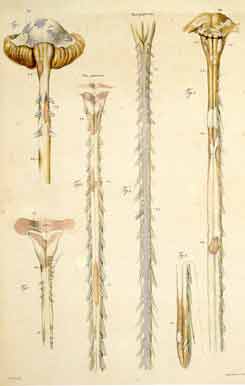|
Plate II.
Click image to enlarge

Significance of the documentation:
In lumping together all the plate’s lesions under the same terms, Cruveilhier’s report initiated a lasting, widespread failure to properly discriminate the specific pathology of Carswell’s “peculiar diseased state“.
|
|
Cruveilhier’s “four cases of grey degeneration of the columns of the spinal cord, by way of a reddish (T.R) or grey (T.G.) [tissue] transformation in the form of
'islands' "
(O.D. right -, and O.G. left olive; label C.R. not explained.)
The basic error:
The lesions of figg. 1, 1’ were considered to represent the same changes – and were accordingly referred to in the same terms - as the totally different lesions illustrated in figg. 2, 3 and 4.
Proper lesion-specifications:
Figg. 1, 1’: Only here can the specific lesion-pattern of Carswell’s peculiar diseased state be identified (three paired scars encroaching on, and more or less deeply into, the cervical spinal cord’s flanks).
Fig. 2: This specimen shows smoothly demarcated swellings, all following the spinal cord’s posterior midline, which occur as focal inflammatory reactions to a systemically spread injurious agent. The spinal cord’s flanks appear spared throughout.
Fig. 3: The continuous affection of the two posterior nerve tracts represents the classic late effects of syphilis. The spinal cord’s lateral columns are completely unaffected.
Fig. 4: Here, a large, confluent area of a smoothly delineated, superficially inflammatory infiltration has occupied most of the spinal cord’s front so that separate plaques are only to be discerned at the spinal cord’s upper and lower ends, as well as in the pons. Moreover, the spinal cord appears distorted by a scar halfway up its length, and the pons is beset with tuberculomas. All these findings point to a repeated seeding of tubercle bacilli in the spinal subarachnoid space. Also, here the spinal flanks are not specifically involved.
|